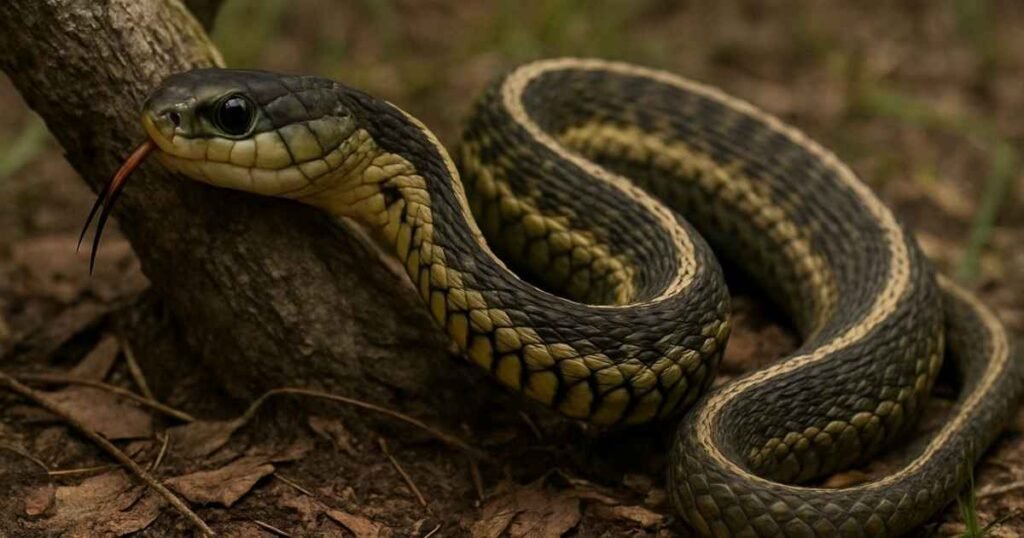Are Garter Snakes Poisonous?
Understanding the Term “Poisonous” in Snakes
The term “poisonous” is often misunderstood when referring to snakes, leading to widespread confusion. In fact, snakes can be venomous, meaning they inject toxins through bites, or non-venomous, meaning they lack venom entirely. When asking “are garter snakes poisonous?” it is important to clarify this distinction. Garter snakes are technically mildly venomous, producing a toxin in their saliva to subdue small prey. Still, this venom isn’t dangerous to humans and poses no significant trouble. Therefore, while garter snakes are not “poisonous” in the traditional sense, they are essential contributors to ecosystems.
Why Garter Snakes Are Often Misunderstood
Garter snakes are often misunderstood due to myths and misconceptions about their nature. Many people ask, “are garter snakes poisonous?” fearing they could be dangerous. These snakes are non-aggressive and generally shy, preferring flight over confrontation. Their mild venom is specifically adapted for their small prey, such as insects, amphibians, and fish, rather than larger animals or humans. By understanding their harmless behavior and ecological role, it becomes clear that garter snakes are not a cause for alarm. Instead, they offer benefits by controlling pest populations and enhancing biodiversity wherever they thrive.
Must Read: Krowd Login: Made Easy for Instant Access
What Makes Garter Snakes Unique?
Physical Characteristics of Garter Snakes
- Size: Garter snakes are generally small to medium- sized, generally ranging from 18 to 26 elevation in length, although some can grow up to 48 elevation.
- Coloration: They feature a distinctive pattern of longitudinal stripes, often in colors such as yellow, green, or blue, against a darker background like black, brown, or olive.
- Scales: Their scales are keeled, giving them a textured appearance, which aids in their movement and camouflage.
- Body Shape: They have slender, elongated bodies that are perfectly adapted for both land and aquatic environments.
- Head: The snake’s head is slightly wider than its neck, with round pupils and small, non-intimidating eyes.
- Variation: Depending on the species and region, garter snakes can exhibit subtle differences in size, markings, and coloration, making them a diverse group within their genus.
Common Habitats and Behavior of Garter Snakes
Garter snakes adapt to various environments, including forests, meadows, wetlands, and even urban areas. They are known for their semi-aquatic nature, making streams, ponds, and marshes ideal habitats. Many people wonder, “are garter snakes poisonous,” but their behavior is typically non-threatening. Garter snakes are most active during the day and are highly skilled hunters, feeding on pests like insects and amphibians. When threatened, they may emit a foul-smelling musk as a defense mechanism, although they rarely bite. These fascinating traits highlight their essential role in ecosystems where they thrive.
Are Garter Snakes Poisonous to Humans?
Effects of Garter Snake Bites on Humans
Many people often ask, “are garter snakes poisonous,” and the answer lies in their mild defense mechanisms. Garter snakes produce a weak venom that’s used to incapacitate small prey, but this venom is n’t dangerous to humans. Their bite may cause slight irritation, redness, or mild swelling in some cases, but these effects are generally short-lived and not dangerous. For most individuals, a garter snake bite poses no serious threat, although it is always wise to clean the bite area thoroughly to prevent infection. Overall, garter snakes are inoffensive and pose no significant peril to humans.
How to Handle a Garter Snake Encounter Safely
If you come across a garter snake, it’s important to approach the situation calmly. Remember, garter snakes are non-aggressive and pose little risk to humans. Do not attempt to handle or provoke the snake, as its first instinct may be to flee or release its musk. If necessary, use a long stick or similar object to gently guide the snake away from your path. Always avoid sudden movements or loud noises, as these can make the snake feel threatened. Understanding that the answer to “are garter snakes poisonous” is no helps foster respect for these helpful reptiles in nature.
Are Garter Snakes Poisonous to Pets?

Potential Risks for Cats and Dogs
For pet owners wondering “are garter snakes poisonous,” it’s crucial to understand the potential risks your pets may face. While garter snakes are not poisonous to humans, their mildly toxic saliva can cause minor irritation in small pets, such as cats or small-breed dogs, if bitten or ingested. Additionally, the snake’s musk—a defensive secretion—can upset a pet’s stomach if licked or swallowed. Most medium to large pets, however, are unlikely to experience significant effects. The primary concern arises from pets trying to capture or play with the snake, which might provoke a defensive reaction. It is always wise to monitor your pet during outdoor activities and redirect their attention if they seem fixated on a garter snake.
What to Do If Your Pet hassles a Garter Snake
When considering “are garter snakes poisonous” and what actions to take after an encounter, remain calm and assess the situation. If your pet seems unharmed, simply deter them from engaging with the snake and allow it to retreat. However, if your pet exhibits signs of irritation, such as swelling, drooling, or lethargy, consult a veterinarian promptly to ensure their well-being. Avoid attempting to handle the snake yourself, as this may increase the risk of bites. Keep your pet’s vaccinations, especially for tetanus, up-to-date as a preventive measure. Outdoor supervision and keeping pets leashed in areas prone to wildlife encounters are excellent precautions to limit interactions with garter snakes and other wildlife.
How to Safely Coexist with Garter Snakes
Tips for Identifying Garter Snakes
Identifying garter snakes is crucial for ensuring peaceful coexistence with these nonvenomous reptiles. Garter snakes typically have slender bodies with longitudinal stripes running along their length. These stripes may vary in color, ranging from yellow, brown, green, or red, depending on the species. Some garter snakes also display checkerboard patterns between their stripes, making them even more distinctive. They are relatively small, with most growing to about 2-3 feet in length.
It’s important to note that are garter snakes poisonous? No, they are not considered dangerous to humans or pets, though they may emit a mild venom to subdue prey. Their heads are slightly wider than their necks, and their scales are keeled, giving them a textured appearance. If you encounter a snake in your yard and are unsure about its species, observing these features can help identify it as a garter snake. Remember, respecting their space and keeping a safe distance is essential when interacting with wildlife.
What to Do If You Encounter a Garter Snake
When you encounter a garter snake, it’s important to remain calm and take steps to minimize potential risks to yourself and the snake. Are garter snakes poisonous? Not in a way that poses significant harm to humans, but they can release a musky odor or attempt to bite if threatened. First, give the snake room to move away, as they are generally shy and prefer to avoid confrontation. Don’t essay to handle, trap, or harm the snake, as this can escalate the situation unnecessarily.
If the snake is in your home or another location where it poses a hazard, contact local wildlife control to safely relocate it. For curious pet owners wondering, “are garter snakes poisonous?”—the answer is still the same. While their mild venom is harmless to humans, some pets may experience slight irritation if bitten. To prevent future encounters, eliminate potential food sources such as insects or small amphibians, and seal gaps around your home where snakes may enter. By respecting their role in the ecosystem and following simple precautions, you can coexist peacefully with garter snakes.
For more informative and interesting articles visit: royallmagazine.com
Common Myths About Garter Snakes
Despite their harmless nature, several myths surround garter snakes, causing unnecessary fear and confusion. Below are some of the most common misconceptions:
- Myth #1: Garter snakes are dangerous to humans.
Truth: While people frequently ask,” are garter snakes toxic?”, their mild venom poses no trouble to humans.
- Myth #2: Garter snakes invade homes intentionally.
Truth: They usually wander indoors by accident in search of food or shelter, not out of malice.
- Myth #3: All garter snakes look the same.
Truth: These snakes vary greatly in color and pattern depending on their species and habitat, yet the question “are garter snakes poisonous?” remains a constant misunderstanding.
By addressing these myths, we can better appreciate garter snakes’ role in nature while dispelling unnecessary fears.
The part of Garter Snakes in the Ecosystem
How Garter Snakes Help Control Pest Populations
Garter snakes play a vital part in maintaining ecological balance by serving as natural pest regulators. They feed on insects, slugs, and small rodents, which helps prevent these populations from growing unchecked and causing damage to crops or gardens. Many people wonder, “are garter snakes poisonous?” The answer often reassures them, as garter snakes are mildly venomous to their prey but not dangerous to humans or pets. Their ability to control pests makes them a crucial part of the food chain, benefiting both agriculture and natural habitats.
Why Protecting Garter Snakes Is Important
Protecting garter snakes is critical for preserving biodiversity and keeping ecosystems healthy. These snakes serve as both bloodsuckers and prey, supporting multiple layers of the food web. Addressing the common question, “are garter snakes poisonous,” highlights the need to dispel misconceptions and encourage coexistence. Their presence curbs pest problems naturally, reducing reliance on harmful pesticides. Loss of garter snake populations could disrupt local ecosystems, allowing pests to overpopulate and leading to a cascade of environmental issues. Consequently, fostering understanding and protection for these non-threatening snakes is essential for a balanced ecosystem.
Conclusion: Are Garter Snakes Poisonous?
Garter snakes are not poisonous and pose no significant threat to humans. While they do produce a mild toxin to subdue their prey, it is harmless to people and rarely even noticed. These snakes are invaluable contributors to local ecosystems, helping control pest populations and maintaining ecological balance. Dispelling myths about garter snakes is key to fostering coexistence and promoting their protection. Their harmless nature, combined with their environmental role, makes them an essential species to safeguard, ensuring healthy ecosystems for the future while minimizing the use of chemical pest controls. Protecting garter snakes benefits both nature and humanity.



